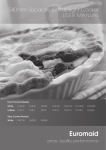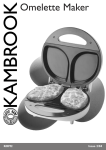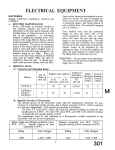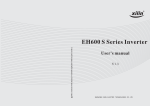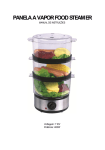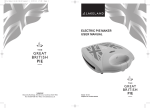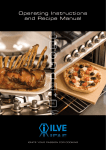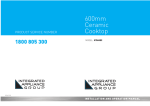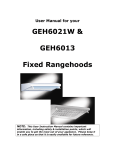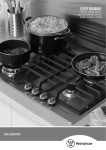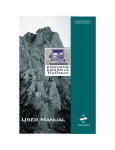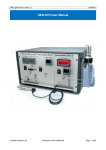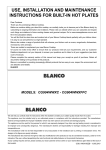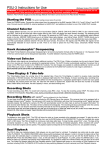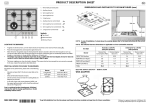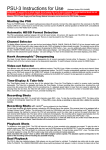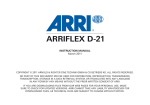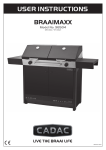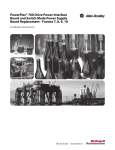Download Operating and Care Instructions
Transcript
Operating and Care Instructions Gas Cooktops Model No’s 5667100 700mm Gas Cooktop 5669100 900mm Gas Cooktop Contents Safety Notes 3 Knowing Your Cooktop 4 Using The Appliance For The First Time 5 Control Panel Operation 5 Cooking Instructions 6 Cleaning And Maintenance 7-8 Troubleshooting Guide 9 Installation Instructions 10-11 Gas Connection Instructions 12 Gas Consumption 13 Electrical Connection Instructions 13 Servicing And Minor Adjustments 14-15 Recipes 16-18 Part Numbers 19 2 Important Points Installation Checks Features And Benefits Gas Burner Controls Recommended Cleaners Routine Cleaning Spills, Spatters And Accidents Measurements Required Clearances Securing The Cooktop Gas Supply Connection Wiring Rules And Warnings Setting Gas Pressure Gas Simmer Flame Adjustment Conversion From Natural Gas To LPG Lubricating Gas Valves Spaghetti With Clams Pea And Ham Soup Paella Valenciana Safety Notes ! • DON’T USE THE APPLIANCE AS A SPACE HEATER. The appliance must never be used for warming or heating the surrounding room or for drying clothes or textiles or other items not specifically recommended in the operation manual. Combustible materials or products must never be placed on or near the appliance. • DO NOT LEAVE CHILDREN ALONE. Children must not be left unsupervised in the area where the appliance is in use. The appliance gets hot during use and retains heat for some time after being turned off. Children must never be allowed to sit or stand on any part of the appliance. • DO NOT SPRAY AEROSOLS IN THE VICINITY OF THE APPLIANCE WHILST IT IS IN OPERATION. • WEAR PROPER APPAREL WHEN USING THE APPLIANCE. Loose fitting, hanging or highly flammable garments (such as synthetics) should never be worn while using the appliance. • USE ONLY DRY POT HOLDERS. Moist or damp pot holders on hot surfaces may result in burns from steam. Do not allow pot holders to touch hot heating elements. Do not use a towel or bulky cloth when handling hot cooking utensils. • DON’T STORE FLAMMABLE ITEMS NEAR THE APPLIANCE. Items, particularly flammable materials, must never be stored on or near surface units. • DO NOT USE OVERSIZE COOKWARE OR PLACE COOKWARE OFF-CENTRE OVER BURNERS. Oversize cookware will deflect heat towards the cooktop and bench top surfaces. Cookware with large bases, especially if placed off-centre over the burners, may cause deterioration of the cooktop and bench top surfaces. Such damage is not covered under the provisions of the warranty. Follow the illustrations and examples in the Cooktop Cooking instructions. • NEVER USE AN ASBESTOS MAT BETWEEN COOKWARE AND COOKTOP. Use of an asbestos mat is both hazardous and will cause damage to the unit. • ONLY PLACE COOKWARE ON PAN SUPPORTS. Other surfaces of the appliance, for example trims, are not totally resistant to hard or sharp materials or direct heat and may be damaged by such use. • If the surface is damaged, switch off the appliance to avoid the possibility of electric shock. • The appliance is not intended for use by young children or infirm persons without supervision. • Young children should be supervised to ensure that they do not play with the appliance. • VENTILATION SLOTS AND AIR VENTS MUST NOT BE COVERED OR OBSTRUCTED IN ANY WAY. Recipes on pages 16-18 are all © The Margaret Fulton Cookbook. Colour photographs are © Geoff Lung, 2004 3 Knowing Your Cooktop Important Points Thank you for purchasing an excellent product that we are sure will provide many years of great cooking experiences. If you haven’t had the pleasure of cooking with one of our appliances previously, you may find that it has different features and characteristics to your last appliance. It is essential you read this operation manual thoroughly to fully understand all of the various functions and operations. The aim is to encourage you to experiment with your cooking and take full advantage of the features of your appliance. The key to achieving results that best suit your personal taste is experimentation. This manual should be retained for future reference. Should ownership of the appliance be transferred, please ensure that the manual is also passed onto the new owner. Installation Checks In the interests of your safety and the care of your new appliance, please take time to carefully read this manual before installing and using it. In particular your attention is drawn to the following: A licensed electrician and licensed gas fitter with relevant qualifications must perform all electrical and gas work when installing or servicing the appliance. The supply cable and fuse rating must be suitable for the appliance. You must never repair or replace any part of the appliance unless specifically recommended in the operation manual. For installation details, please refer to Gas Connection Instructions, and Electrical Connection Instructions. Incorrect installation of the appliance as a result of not following the detailed instructions can affect performance and pose a safety hazard. Appliances incorrectly installed may invalidate the warranty and we strongly recommend that the cavity, venting, wiring and gas connection be prepared as described in the instructions. This is critical to appearance, performance and safety. For installation details, please refer to Installation Instructions. Features And Benefits Gas cooktop models incorporate electronic ignition and fast take-off gas burners for effective lighting and heat production. Both gas models have Flame Failure Device control for complete safety. All pan supports are removable and dishwasher safe. Cleaning the cooktop is made simple with high quality vitreous enamel and stainless steel (refer to Cleaning and Maintenance for complete care instructions). 5667100 4 5669100 Using The Appliance For The First Time After installation remove all notification labels (not gas or electrical warning labels), advertising, tape, packaging, etc. A quick wash with diluted soapy water should rinse away any adhesive residue. Eucalyptus oil (small amounts) is also good for removing adhesive residue. Thoroughly rinse cleaned surfaces and wipe them dry using a clean, soft cloth. NOTE: People with sensitivity to cleaning chemicals must take the necessary precautions. It is recommended that protective gloves be worn while cleaning the appliance. INITIAL HEAT UP Some smoke and smell may be noticed during the initial heat up cycle (see Using the Appliance for the First Time). This should quickly dissipate. If abnormal levels of smoke are observed (i.e. it is not food that is burning) have the appliance thoroughly checked. Control Panel Operation Gas Burner Controls The cooktop burners are ignited by the in-built electronic ignition controls. The controls must be turned anti-clockwise to operate and can only be turned clockwise to the off position. Alternatively, the burner may be ignited manually using matches, cooktop gas lighters or similar devices, being careful not to risk injury or damage. To operate the controls ensure the burners are correctly assembled and positioned over the gas burner outlets and the pan supports are correctly positioned then: High Low 1. Start the gas flow by pressing down and turning the control knob corresponding to the burner you wish to use anticlockwise. Pressing down on the control knob causes the igniters to spark. NOTE: These units are fitted with Flame Failure Safety Devices. These require the controls to be fully depressed during ignition to ensure correct operation. The controls should be held fully down for at least 10 seconds during the ignition and flame establishment period to ensure the valve remains open after the knob is released. 2. Once the flame is established the knob need no longer be pressed and may be turned to your required setting. 3. The flame can then be turned down by turning the control knob further anti-clockwise. 4. For Wok Burner: Once the flame is established using the normal procedure described above, it can be turned down by turning the control knob further anti-clockwise. Press the control knob again and continue turning anti-clockwise to extinguish the outer ring flame and provide a full control high-to-low inner ring flame for simmering applications. Check for a clear blue flame without excessive yellow tipping. If burners show any abnormal combustion check they are correctly located on the burner base. NOTE: Sometimes burners may not ignite immediately and may seem to “blow” slightly when they do ignite. This is usually due to air in the gas line, which should clear itself. For minor adjustments see Servicing and Minor Adjustments. A 2 yearly inspection of the appliance by an authorised service agent will ensure many years of trouble-free service. (NOTE: This is not provided under warranty). 5 Cooking Instructions To achieve the best possible cooking results, the following points are recommended: • Make sure that both the cooktop surface and the bottom of your cookware are clean and dry before cooking. Clean and dry surfaces will help prevent scratches and stains on your cooktop and cookware. • Use good quality saucepans with thick ground bases (preferably 5mm thick) that effectively cover the heating area. Pans which have smooth, slightly concave or flat bases when cold will expand and become flat when hot. Thin, warped, dented or ridged bases can cause irregular heat distribution resulting in uneven heating of food. Quality stainless steel pans are recommended. • The size of the pan should closely match the size of the cooking zone to be used – not much wider or narrower. If the diameter of the base of the cookware is much smaller than the diameter of the cooking zone, you will waste energy and increase the risk of burning spills. If the cookware is too large for the burner, time to boil will be longer. • When using the Wok burner, use pans with bases larger than the diameter of the burner. When using the Wok burner at full power, it is recommended to use only Wok pans or frying pans on the burner. Smaller pans may not provide enough clearance from the flame making the handle/s too hot and unsafe to hold. For greater stability, use the supplied Wok ring. • Use a set of twin or triple saucepans with dividers when individually cooking several vegetables at the same time using only one burner. • When steaming, use saucepans with close fitting lids. • When cooking food such as cut vegetables or fruit, cut the food into pieces of uniform size to obtain even cooking. • When cooking vegetables use a minimum amount of hot water to obtain a crisp texture and prevent over cooking. The quantity of water will depend on the type, quantity and quality of the vegetables being cooked. With the exception of frying, etc., always cook with the lid on the saucepan at the correct heat level to prevent boilovers. •When cooking in woks or convex-bottom vessels, it is strongly recommended to use the Wok ring supplied with the appliance. ! WARNING: Oversize cookware will deflect heat towards the cooktop and bench top surfaces. Cookware with large bases, especially if placed off-centre over the burners, may cause deterioration of the cooktop and bench top surfaces. Such damage is not covered under the provisions of the warranty. HEAT DEFLECTED TOWARDS BENCHTOP 6 Match size of pan to appropriate burner HEAT EXTENDED BEYOND BASE OF PAN Cleaning And Maintenance Proper cleaning and maintenance of your appliance will provide you with years of pleasant use. To maintain the appearance and durability of your appliance we encourage you to read and follow the instructions, hints and warnings included throughout this manual. Care must always be taken to prevent scratches on your appliance from hard or sharp objects. NOTE: People with sensitivity to cleaning chemicals must take the necessary precautions. It is recommended that protective gloves be worn while cleaning the appliance. Routine cleaning of the appliance should only be performed when the appliance is at room temperature. DO NOT USE ANY ACIDIC OR CAUSTIC CLEANERS, ABRASIVE POWDERS OR SCOURERS ON ANY SURFACES OF THE APPLIANCE. Substances or items with these properties may discolour or damage the finishes of your appliance. If any abrasive, acidic or caustic substance or cleaning agent should come into contact with the appliance, rinse off immediately with water, taking special care to avoid injury if surfaces are hot. Recommended Cleaners Mild detergents and warm water together with a clean, soft, non-abrasive cloth achieve good results for normal cleaning. Washing with diluted soapy water should rinse away any adhesive residue or gummy deposits on the appliance surfaces. Eucalyptus oil (small amounts) is also good for removing adhesive residues. Alcohol based products (e.g. methylated spirit, etc.) are not recommended. Brand name cream cleansers and concentrates, without abrasive qualities, can be used in small amounts to break down greasy deposits and dirt. Aggressive chemical cleaners such as bleach or caustic oven cleaners may etch or discolour surfaces or lift paint from trims and are specifically not recommended. After cleaning, make sure cleaned surfaces are thoroughly rinsed to prevent any risk of bakedon cleaner residues, and wipe dry with a clean, soft cloth. NOTE: When cleaning stainless steel surfaces, St George recommends using dedicated stainless steel cleaning agents such as SteelPower by Hillmark, or any other reputable brand cleaners specially formulated for cleaning stainless steel. When cleaning surfaces which have a brushed stainless steel finish, take care to wipe in the same direction as the grain. Do not use steel soap pads or abrasive scourers of any kind. The abrasive qualities of these pads will ruin the even brushed finish of the stainless steel and any residual metal fibres may corrode causing a rusty/ dull appearance. Metal polishes with abrasive qualities are also not recommended. 7 Cleaning And Maintenance (Continued) DO NOT USE ANY ACID OR CAUSTIC CLEANSERS OR ABRASIVE POWDERS OR SCOURERS ON THE INTERIOR OR EXTERIOR OF THE APPLIANCE Spark Probe Burner Cap Gas outlets should be free of obstructions Flame Failure Routine Cleaning If possible, the cooktop should be wiped down after each use to prevent dirt and grease build up. Ensure all controls are off and the appliance is cool before cleaning. To clean the exterior, wipe the knobs, stainless steel and enamel surfaces regularly using a warm, damp, non-abrasive cloth. Mild detergents may be safely used on all of these surfaces. When wiping stainless steel surfaces which have a brushed finish, wipe in the same direction as the brushing. The pan supports easily lift off and are dishwasher safe. The gas burner parts can be simply lifted off for cleaning. After cleaning, check that the gas holes are clear before drying and correctly repositioning them. After cleaning make sure all surface are thoroughly rinsed and then wiped dry with a clean, soft cloth. ! WARNING: Unclean surfaces, especially if allowed to build up, may in time damage or discolour the appliance and such stains may not be removable. Spills, Spatters And Accidents When using the appliance, it may become soiled by food spills and spatters or foreign items such as plastics accidentally coming into contact with warm or hot surfaces. Some foods, such as fruit juices (especially citrus juices like lemon juice) and vinegars (i.e. acidic substances) or sugar (or foods containing sugar) can discolour or damage enamel finishes. The surfaces of your appliance have durable finishes which are resistant to wear and discolouration. However, to maintain the appearance and durability of the finish any spills must be wiped off immediately. This should be done as soon as possible and necessary precautions must be taken to avoid injury from hot surfaces. Once cool, the affected area should be thoroughly cleaned and rinsed using non-abrasive, mild cleaning detergents and water. 8 Troubleshooting Guide Problem Possible Cause Action No ignition No spark See next Problem No gas Check gas is not turned off or empty Spark “escaping” Clean around electrode and burner cap No electric power Check that the cooktop is plugged into the power, and that power is available Switch not pressed Press the knob a bit harder, then try other knobs Did not press knob long enough Hold the knob down a bit longer No spark Flame not holding Thermocouple not in flame Check the thermocouple is in place, is clean and unobstructed Not enough air entering Flame falters Flame irregularity Check that air entry inlets are clean and free of obstructions Draught around appliance Ensure that there is not too much air draught around the cooktop Air in gas Keep running for a while to see if it clears itself, or contact your gas supplier Burners not assembled properly Check that the burner is assembled properly For any other problems, or if the guidelines in this table could not resolve your problem, please contact a qualified service technician to check your cooktop. 9 Installation Instructions Your safety and the proper care of your appliance is extremely important. Incorrect installation of the appliance as a result of not following these detailed instructions can affect the appliance’s performance. Appliances incorrectly installed will invalidate the warranty and we strongly recommend that the cavity, venting, wiring and gas connections be prepared as described in the instructions. This is critical to appearance, performance and safety. ! WARNING: Installation must comply with Standards Australia Wiring Rules (within Australia) as well as your local electrical and building codes and regulations and any other applicable requirements. Your appliance must be properly installed and grounded by a qualified person. This appliance must be installed according to the installation requirements of the local gas authority and the appropriate installation code issued by AS5601) and the building authorities’ requirements and any other applicable requirements. Measurements Unless otherwise noted, all dimensions provided are in millimetres (mm). The sizes allow for only a small degree of error, so all cut-outs must be precise and square. To ensure the cabinetry is well finished the cut edges must also be square and care taken to ensure the cut edges are free of chips. Note: Cutout is to have square corners. 5669100 5667100 520 520 700 900 52 52 488 875 488 560 77 77 The duplicate rating plate must be attached to an adjacent surface for easy viewing, without the necessity of removal of the appliance. 10 Installation Instructions (Continued) Required Clearances (Required Clearances Around Domestic Cooking Appliances – Extract from AS5601) All cooktops, rangehoods and/or exhaust fans shall be installed in accordance with the manufacturer’s instructions. However, in no case shall the clearance between the top of the highest burner on the cooktop to the lowest extruding part of a rangehood be less than 650mm. Minimum clearance for an exhaust fan is 750mm. (Clause 5.12.1.5) Any other combustible materials less than 600mm above the top of the highest burner shall be protected for the full width and depth of the cooking surface. However, in no case shall this clearance be less than 450mm. There shall be a clearance of at least 250mm between the closest edge of any burner and a wall to the left, right or rear of the cooktop. Overhead clearance shall be at least 650mm, measured from the top of the burners. Securing The Cooktop The final gas connection shall be made using a flexible hose or annealed copper tubing of sufficient length to permit the insertion and removal of the appliance. For gas appliances connected using flexible hose, the hose . For appliances fitted with a flexible electric lead and plug, the general purpose outlet and switch must not be installed within the appliance recess and must be readily accessible without having to remove the appliance. The unit must be securely clamped to the benchtop, using the clamps supplied, once correctly positioned. Refer to the diagram below for clamp arrangement. Clamping cooktop to benchtop surface BENCHTOP COOKTOP UNIT SHOWN CLAMPED TO 24mm BENCHTOP USE SECOND SLOT IN BRACKET FOR THICKER TOPS 11 Gas Connection Instructions Gas Supply Connection ! WARNING: This appliance must be installed by an authorised and qualified person, according to the installation requirements of the local gas authority and the appropriate installation code issued (within Australia) by authorities’ requirements and any other applicable requirements. 1. Check the gas type of the appliance which is identified by a sticker attached to the appliance. 2. Ensure the location of the gas supply and routing of the gas line is appropriate for the appliance (see installation diagrams for gas connection location details). 3. Ensure that the supply connection point will be accessible when the appliance is installed. 4. Use of a hose assembly must comply with AS5601. 5. A restraining wire or chain of adequate strength is to be fixed to the appliance and the wall within 50mm of each connection point. The length of the chain or wire is not to exceed 80% of the length of the hose assembly. 6. It is recommended that a manual shut-off valve be installed in the gas supply line, in an accessible position external to the appliance, such that the gas supply to the appliance can be shut off in the event of an emergency or for servicing without having to remove the appliance. 7. For LPG models, the gas supply for the appliance must be regulated to a pressure of 2.75kPa (11” W.G.). The gas inlet is fitted with an adaptor incorporating a pressure test point and has a ½” female BSP thread. For Natural Gas models, the gas supply is connected to the regulator supplied with the appliance, which has a ½” female BSP thread. IT IS ESSENTIAL THAT THE REGULATOR ON THE APPLIANCE BE HELD FIRMLY WITH A SPANNER WHEN CONNECTING THE SUPPLY. DO NOT OVERTIGHTEN. THE REGULATOR MUST NOT BE CONNECTED TO THE APPLIANCE OR THE GAS SUPPLY WITHOUT THREAD SEALANT/LUBRICATION AS DRY CONNECTION MAY PERMANENTLY BIND THREADS. The regulated pressure for Natural Gas is 1.0kPa (4” W.G.). 8. After installing the gas supply and making all connections, the supply line connections must be checked for possible leaks. With all controls of the appliance in the off position, open the gas supply valve and using a soap and water solution check each gas connection one at a time by brushing the solution over the connection. The formation of bubbles indicates a leak. Tighten the fitting and recheck for leaks. If it is not possible to correct the leak by tightening, replace the fitting. Matches and lighters must never be used to check for leaks. 9. Turn on each burner control and light in turn. Check for a clear blue flame without excessive yellow tipping. If burners show any abnormal combustion check they are correctly fitted. Sometimes burners may not ignite immediately and may seem to “blow” slightly when they do ignite. This is usually due to air in the gas line, which should clear itself. 10. If, after following the instructions, satisfactory performance cannot be obtained, contact the local gas authority for advice and assistance. 11. For minor adjustments see Servicing and Minor Adjustments. 12. A two (2) yearly inspection of the appliance by an authorised service agent will ensure many years of trouble free service (Note: This is not provided under warranty). 12 Gas Consumption Burner Natural Gas (1.00 kPa) LPG Propane (2.75 kPa) Injector Diameter (mm) Nominal Gas Consumption (MJ/hr) Injector Diameter (mm) Nominal Gas Consumption (MJ/hr) Small 0.90 4.0 0.55 4.0 Medium 1.25 6.9 0.70 6.9 Large 1.45 10.2 0.88 10.2 2.20 + 0.75 22.0 1.20 + 0.53 22.0 0.75 2.6 0.53 3.2 Wok (Outer + Inner) Wok (Inner) Total: Model 5667100 = 43.1 MJ/hr Total: Model 5669100 = 53.3 MJ/hr Electrical Connection Instructions Wiring Rules And Warnings ! WARNING: All aspects of the installation must conform with the requirements of the Standards Australia Wiring Rules (within Australia) as well as your local electrical and building codes and regulations and any other applicable requirements and conditions of your Local Power Supply Authority. NOTE: To the Electrician – please ensure sufficient supply cable is provided to allow the appliance to be removed from the cavity should any servicing be necessary. This will also allow easy connection of the supply. These cooktops are supplied with a flexible lead (approx 1m in length). Please ensure the power connection is within reach of the cable. Gas appliances referred to in this manual have a maximum electrical load of 5W. 13 Servicing And Minor Adjustments All service work, minor or not, must be performed by a suitably qualified and licensed person. Setting Gas Pressure A pressure test point is provided on the pressure regulator (for Natural Gas models) or on the inlet adapter (for LPG models) at the gas connection point of the appliance. The pressure should be set with one burner fully on. The set pressure should be 1kPa for Natural Gas or 2.75kPa for LPG Propan. Gas Simmer Flame Adjustment The minimum gas flow for each burner is factory set but can be adjusted if necessary. The minimum flow can be increased or decreased by removing the control knob and hob to gain access to the adjustment screw on the valve body, and then turning the adjustment screw using a small flat bladed screwdriver. Take care to not damage the head of the screw. NOTE: The Wok burner valve has two adjusting screws, one for each of the burner flames. Conversion From Natural Gas To LPG The following must be carried out by an authorised person. General Information If the hob is supplied pre-adjusted for Natural Gas: 1. The injectors required for adapting this appliance to LPG are supplied in the conversion kit (see sizes in the table under Gas Consumption). 2. When the appliance has been converted to LPG tick the box on the injector information label. 3. Change the black Natural Gas labels to the red LPG labels. Conversion 1. Remove the pan-support locating pins, pan supports, burner caps, burner ring/dress rings and knobs. 2. Remove the hob. 3. Remove the fitted injectors one by one and replace with the LPG injector sized as the label attached to the appliance and also in the users manual. NOTE: Wok injectors are in the tubes leading to the burner. 4. Fit the Test Point Adaptor at the gas inlet. 5. After fully leak testing and working on each burner in turn, light each burner and then adjust the minimum flame via the adjustment screw in the gas cock. With the gas cock set in the low flame position, turn the adjustment screw clockwise to reduce the flow to the required level. Two burners should be operating on full while adjusting each burner. 6. Replace the hob using all spacer rings. 7. Replace all the burner parts ensuring that they are correctly keyed to the mating part. 8. Replace the control knobs, pan support pins and pan supports. 14 Servicing And Minor Adjustments (Continued) Lubricating Gas Valves The gas valves may require periodic lubrication depending on their frequency of use. To lubricate the valves: 1. Turn off the gas and electricity supply to the appliance. 2. Remove the pan supports, control knobs and burner assemblies. 3. Disassemble the pan support locating pins and then remove the hob. 4. Dismantle the valve body by removing the screws retaining the control shaft assembly (refer to diagram if necessary). 5. Remove and clean the cone with a cloth and suitable dilutant. 6. Ensure the cone is clean and dry and slightly grease the outside with Ragosine Moly LM or approved alternative graphite lubricant. 7. Replace the cone, rotate it and remove it. Wipe off any excess grease ensuring that the gas holes are clear. 8. Replace the cone and re-assemble the valve body. Re-assemble the hob and other components. Pressure adjustment screw Pressure test point 15 Recipes The recipes on these pages are provided to help you enjoy your cooktop. All recipes are © The Margaret Fulton Cookbook. Spaghetti With Clams 1.5kg clams 1 cup white wine 5 small ripe tomatoes, cut into large dice ½ small chilli, seeded and finely sliced 1 large clove garlic, finely chopped 2 tbsp extra virgin olive oil ¼ cup chopped parsley salt and freshly ground pepper 375g spaghetti Wash the clams thoroughly in several changes of water. Discard any that do not shut when tapped. Soak them in cold water for 1 hour, then drain them to remove the sand, rinsing them thoroughly again. Heat the wine in a large saucepan. Add one-third of the clams, cover and cook until all are open. Make sure you shake the pan to mix the clams several times during cooking. Repeat with remaining clams in 2 more lots. When cool enough to handle, remove the clams from the shells, leaving just a handful intact for the garnish. Discard the shells, reserving the flesh. Meanwhile, combine the tomatoes, chilli and garlic in a bowl with the olive oil. Add the clams and season well with salt and pepper. Stir in the parsley. Boil the spaghetti in a large saucepan of boiling, salted water until done to the bite, al dente. Drain thoroughly, return to the saucepan and toss with the clam sauce over a moderate heat, until heated through. Serves 4–6. 16 Recipes Pea And Ham Soup 500g split peas 2 rashers bacon, diced 2 onions, sliced 2.5 litres (10 cups) water ½ tsp freshly ground black pepper 1 sprig fresh thyme 1 bay leaf 1 ham bone 2 carrots, diced 1 cup sliced celery 2 tsp salt or to taste 2 tbsp lemon juice croutons (optional) Cover the peas with cold water and soak overnight. In a large saucepan, sauté the bacon, then add the onions and sauté until they are golden. Add the drained peas, water, pepper, thyme and bay leaf. Add the ham bone. Bring slowly to the boil, reduce the heat and simmer, half-covered, for 1 hour. Add the carrot and celery and continue to cook for another hour. Remove the thyme and bay leaf and discard. Take out the ham bone, cut all meat from the bone, removing excess fat and any skin, dice and return the meat to the soup. Add the salt and lemon juice just before serving. Serve with croutons, if liked. Serves 6–8. NOTE: Sliced frankfurts or spicy smoked sausage may be heated in the pea and ham soup. It is then suitable as a main course for lunch. 17 Recipes Paella Valenciana ½ tsp saffron threads 5 cups chicken stock ½ cup olive oil 4 half chicken breasts 2 onions, chopped 2 cloves garlic, chopped 1 red capsicum, seeded and cut into strips 2½ cups rice, washed and drained 2 tomatoes, peeled and cut into eights 1 cup shelled green peas 500g seafood such as scallops, prawns, calamari or mussels Bring the saffron and stock to the boil and set aside, until ready to use. Heat half the oil in a paella pan or frying pan. Sauté the chicken breasts until golden. Remove and cut each one into 3. Add the onion, garlic and capsicum strips, with more oil if necessary, and cook gently until soft. Remove the capsicum and set aside. Add the rice and fry gently for 3–4 minutes. Add the stock. When bubbling, reduce the heat and start the decoration of the paella. Add the chicken, capsicum, tomatoes and peas in a pattern, and the remaining foods around. If using seafood, add it for the last 10 minutes of the cooking time. Add more stock if necessary, cover with foil, and cook gently until the rice is cooked, for about 20–25 minutes. Serves 8. 18 Part Numbers 4 1 2 3 7 6 8 10 11 12 9 5 15 14 18 17 13 16 Item No Part No Description Quantity 5669100 Quantity 5667100 1 52243 Trivet Left 1 1 2 52478 Trivet Mid Large 1 ‑ 3 52244 Trivet Right 1 1 4 52479 Wok Ring 1 1 Hob 52249 52242 5 6 52480 Wok Burner GG-503 1 1 7 52482 Medium Burner GG-535A 1 1 8 52481 Large Burner GG-535B 2 1 9 52483 Small Burner GG-535H 1 1 10 52491 Fix Stud 12 8 11 52490 Air Entry Inserts 3 2 12 52489 Cooktop Knob 5 4 Drop-in Body 52476 52477 4 3 13 14 52492 Burner Bracket - Long 15 52493 Burner Bracket - Wok 1 1 Manifold Pipe 52318 52317 16 17 52485 LP Burner Valve 4 3 18 52484 Wok Burner Valve 1 1 19 52596 V0.1




















